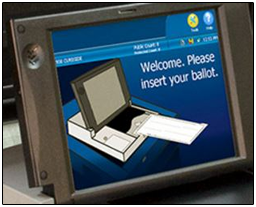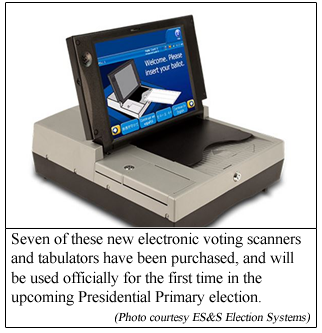|
Elections and voting in
Boundary County will take a technological leap
forward this year.
Two months from today is
the Idaho Presidential Primary election,
scheduled for March 8.
Boundary County voters on that day will
find there has been a substantial change in how
they cast their ballots.
Up until now, ballots in
Boundary County were counted by humans, and by
hand.
Four or five poll workers staffed the
vote counting rooms.
One worker would read each ballot aloud,
one at a time, while a second worker observed
closely as a witness to make sure the ballot was
read correctly.
Two or three other poll workers would
tally votes as the ballots were read.
After every 25 ballots, they would stop,
and the workers tallying the votes would compare
and balance their counts to ensure all were
recording the same totals.
Poll workers in the counting rooms were
not allowed to leave the room until all votes
were counted.
This system led to some
long nights for poll workers and for county
officials in charge of elections.
"In years past, we have been in the
office till 4:00 a.m. waiting for results from
polls," said Glenda Poston, Boundary County
Clerk/Auditor/Recorder.
New System makes things easier
That shouldn't happen this
next election.
Boundary County now has seven brand new
electronic vote scanner/tabulator machines, and officials plan
to deploy those machines for the first time in
the next election, which is the March 8
Presidential Primary.
scanner/tabulator machines, and officials plan
to deploy those machines for the first time in
the next election, which is the March 8
Presidential Primary.
So how will counting votes
now happen, in 2016 and beyond, with these new
machines?
Here is the new scenario:
You travel to your usual polling
location, and check in and verify that you are a
registered voter, just like in the past.
You receive your ballot from the friendly
election workers, proceed to the voting booth,
and mark your ballot, all just like in the past.
Once your ballot is marked, that's where
things change.
Once your ballot is marked,
you place it in a "secrecy sleeve" (if you
wish), step over to the county's new electronic
scanner/tabulator, and insert your ballot into
the machine.
The electronic scanner/tabulator will
thank you for voting, and an election official
confirms that you have voted.
The counting magic starts
once the polls close for the day at 8:00 p.m.
At that time, workers will run reports
from the tabulators, will post results on the
doors of the precinct polling sites, and the
County Clerk's office will be notified of the
precincts' results.
Final county-wide totals will be tallied
by staff at the County Clerk's office, and all
the vote counting is completed that quick.
Ms. Poston is hoping to receive reports
from individual precincts at her office at the
Courthouse within half an hour after the polls
close, by 8:30 p.m., with final results
calculated and posted by 9:30 or 10:00 p.m.
Much better than 4:00 a.m.
The ballots used with these
new machines will look a little different.
Perhaps one of the main differences is
that instead of the voter marking a box next to
a candidate's name or a next to a question, as
done with previous ballots, voters will now have
an oval to fill in.
These ovals are what the electronic
scanner reads.

Details on the new
electronic machines
The new electronic machines
are DS 200 Precinct Tabulation Scanners, which
the county purchased last October from ES&S
Elections Systems and Software of Omaha,
Nebraska.
Ms. Poston says she has
seen these tabulators at several conferences
over the years, and discussions have been held
from time to time about possibly getting some
for use here in Boundary County.
"We have talked off and on about this
type of tabulator.
Counties smaller than ours and larger
than ours have used this tabulator for several
years, and have nothing but positive comments
regarding its use and reliability."
Acquiring the new
machines
In March 2015, a
representative from ES&S Elections Systems and
Software traveled to Boundary County to
demonstrate the machine for the County Clerk's
office and other election officials.
Following this demonstration, "We
received nothing but positive comments," said
Ms. Poston. "So we started to proceed with
purchase arrangements."
The seven machines
purchased, one for each of Boundary County's
voting precincts, cost a total of $51,516.67.
Although the county made the original
payment to procure the machines, the purchase
price was fully reimbursed 100% about a week
afterward by the Idaho Secretary of State
office.
The state funds used to reimburse
Boundary County came from Idaho's Election
Consolidation Fund, which is a reimbursement
program established by the Idaho Legislature to
pay for county expenses to implement the 2009
Election Consolidation laws.
The new Election
Consolidation laws of 2009 brought significant
changes to elections in Idaho, among other
things putting the County Clerks in charge of
running elections for all government entities
within a county (with just a few exceptions),
and providing funds from the state to provide
for the counties to implement Consolidation,
including the purchase of voting equipment.
Election officials
will be ready
Now that Boundary County
has these machines, and the election staff has
had all the necessary instruction and training,
election officials plan a test run in the days
just prior to the real March 8 Presidential
Primary election.
In addition, staff from ES&S Elections
Systems will be onsite, ready to provide
technical support or to troubleshoot as may be
necessary.
Ms. Poston notes that these
machines will likely not be used for elections
that historically have a low turnout, or that
involve simple Yes/No questions for voters, such
as municipal elections or school district
voting.
Those elections will probably be run with
the traditional paper ballots.
So, hopefully, no more
late, late night and early hours of the morning
vote tabulations for Boundary County's election
officials and poll workers.
Ms. Poston has an observation on that,
also:
"I would like to compliment our poll
workers.
They are dedicated to their job, and they
do a wonderful job.
But it is hard to find poll workers and
then expect them to be onsite for 15 to 17
hours.
Our goal is to improve this process, to
get the results out earlier, and to relieve some
of the hours needed to be a poll worker."
Modernizing Boundary
County's voting system with these newly acquired
machines should go a long way toward
accomplishing those goals.
|

